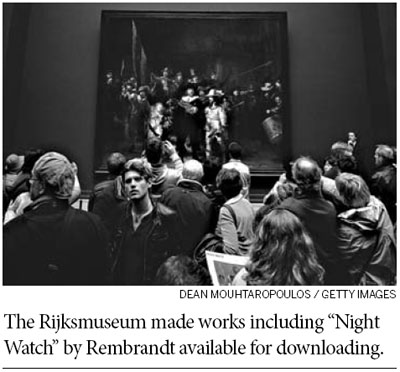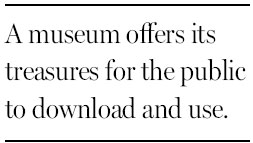Feel free to copy the Rembrandts
Updated: 2013-06-09 05:48
By Nina Siegal(The New York Times)
|
|||||||

AMSTERDAM - Many museums post their collections online, but the Rijksmuseum here has taken the unusual step of offering downloads of high-resolution images at no cost, encouraging the public to copy and transform its artworks as it chooses: into stationery, T-shirts, tattoos, plates or even toilet paper.
The museum, whose collection includes masterpieces by Rembrandt, Vermeer, Mondrian and van Gogh, has already made images of 125,000 of its works available through Rijksstudio, an interactive section of its Web site. The staff's goal is to add 40,000 images a year until the entire collection of one million artworks spanning eight centuries is available, said Taco Dibbits, the director of collections at the Rijksmuseum.
"We're a public institution, and so the art and objects we have are, in a way, everyone's property," Mr. Dibbits said. "With the Internet, it's so difficult to control your copyright or use of images that we decided we'd rather people use a very good high-resolution image of the 'Milkmaid' from the Rijksmuseum rather than using a very bad reproduction," he said, referring to that Vermeer painting from around 1660.
Until recently, museums had been highly protective of good-quality digital versions of their artworks, making them available only upon request to members of the press or to art historians and scholars, with restrictions on how they could be used.
The reasons are manifold: protecting copyrights, maintaining control over potentially lucrative museum revenues from posters or souvenirs and preventing thieves or forgers from making convincing copies.
There is also the fear that a piece can lose its aura, or authenticity, when it is reproduced so often that it becomes too familiar - cheapening the "Mona Lisa," for instance.
In recent years, though, as the Google Art Project has begun to amass a global archive of images with the cooperation of museums and the Internet has made it impossible to stem the tide of low-quality reproductions, institutions are rethinking their strategy.
"We've gotten over that hurdle," said Deborah Ziska, a spokeswoman for the National Gallery of Art in Washington. "I don't think anyone thinks we've cheapened the image of the 'Mona Lisa.' People have gotten past that, and they still want to go to the Louvre to see the real thing. It's a new, 21st-century way of respecting images."
The National Gallery has so far uploaded about 25,000 works to share with the public. "Basically, this is the wave of the future for museums in the age of digital communications," Ms. Ziska said. "Sharing is what museums need to learn to do."
The Rijksmuseum has been able to put its works online more quickly because much of its collection predates Dutch copyright laws and its staff had an opportunity to digitize the collection when the museum was closed for renovations. The digitization project was financed by a million-euro ($1.29 million) grant from the national BankGiro lottery, which provides money for the arts and cultural groups.

Rijksstudio has logged more than 2.17 million visitors since its service went online in October, and around 200,000 people have downloaded images.
Rijksstudio is unusual among digital museum projects in that it provides online tools for manipulating, changing or clipping the images, said Jennifer Trant, a co-founder of Museums on the Web. The online studio asks people to refrain from commercial uses and sells images of an even higher resolution that are more suitable for that purpose.
At the National Gallery in London, the collection of 2,500 artworks has been digitized and made available for academic purposes, but the museum has not provided free downloads.
The Smithsonian Institution in Washington has 137 million works in its coffers and has chosen 14 million of those for digitization, said a spokeswoman, Linda St. Thomas. It has made about 860,500 images, video clips, sound files, electronic journals and other resources available online, but the images of artworks are all low resolution - again, to discourage commercial use.
Mr. Dibbits of the Rijksmuseum maintains that letting the public take control of the images is crucial to encouraging people to commune with the collection. "The action of actually working with an image, clipping it out and paying attention to the very small details makes you remember it," he said.
To inspire users, the Rijksmuseum invited the Dutch design cooperative Droog to create products based on its artworks. Its designers used part of a 17th-century flower still life by Jan Davidsz de Heem as a template for a tattoo, for example.
Are there limits to how the Rijksmuseum's masterpieces can be adapted? Not many, Mr. Dibbits suggested.
He said, "If they want to have a Vermeer on their toilet paper, I'd rather have a very high-quality image of Vermeer on toilet paper than a very bad reproduction."
The New York Times
(China Daily 06/09/2013 page12)